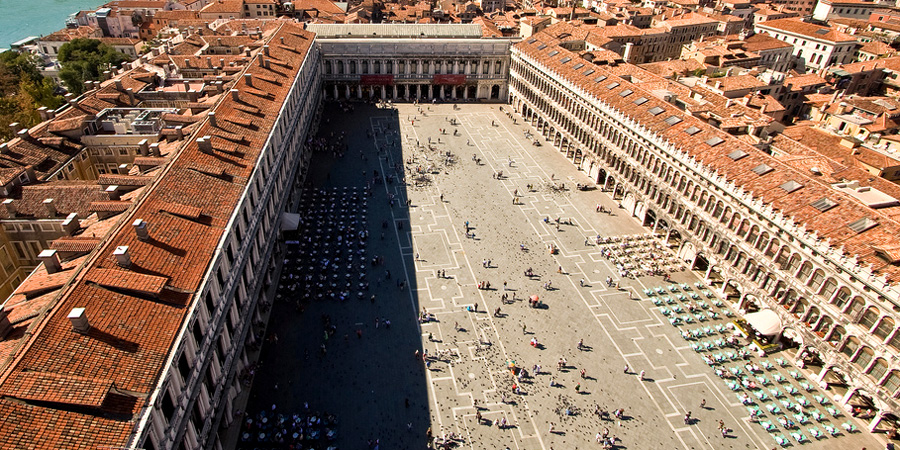La Plaza de San Marcos en Venecia es una de las plazas italianas más importantes, reconocida en todo el mundo por su belleza y composición arquitectónica.
Es la única zona urbana de Venecia, que lleva el nombre de piazza, todos los demás espacios en forma de plaza están propiamente definidos como campi. Tiene forma trapezoidal y mide 170 metros de largo. La plaza está dominada en su extremo oriental por la gran iglesia de San Marcos. Se describirá mediante un paseo que comienza desde el frente oeste de la iglesia (mirando a lo largo de la plaza) y continúa hacia la derecha. La iglesia se describe en otra parte, pero hay aspectos de ella que forman parte de la plaza y que deben mencionarse aquí, incluida toda la fachada oeste con sus grandes arcos y decoración de mármol, las tallas románicas que rodean la puerta central y , sobre todo, los cuatro caballos que presiden toda la plaza y son potentes símbolos del orgullo y el poder de Venecia.
La iglesia se describe en otra parte (ver Basílica de San Marcos), pero hay aspectos de ella que son una parte tan importante de la Piazza que deben mencionarse aquí, incluida toda la fachada oeste con sus grandes arcos y decoración de mármol. , las tallas románicas que rodean la puerta central y, sobre todo, los cuatro caballos que presiden toda la plaza y son símbolos tan potentes del orgullo y el poder de Venecia que los genoveses en 1379 dijeron que no podía haber paz entre las dos ciudades. hasta que estos caballos fueron embridados y, cuatrocientos años más tarde, Napoleón, después de haber conquistado Venecia, los hizo desmontar y enviar a París.
Se empieza cruzando la Piazzetta dei Leoncini, un espacio abierto en el lado norte de la iglesia que lleva el nombre de los dos leones de mármol (presentados por el dux Alvise Mocenigo en 1722) sobre los que los niños suelen trepar, pero que ahora se llama oficialmente Piazzetta Giovanni XXIII.
Más allá está la Torre del Reloj , terminado en 1499, sobre un alto arco donde la calle conocida como Merceria (una vía principal de la ciudad) conduce a través de calles comerciales hasta Rialto, el centro comercial y financiero. A la derecha de la torre del reloj se encuentra la iglesia cerrada de San Basso, diseñada por Baldassare Longhena (1675), a veces abierta para exposiciones.
Turning left and following the long arcade along the north side of the Piazza, the buildings on this side are known as the Procuratie Vecchie, the old procuracies, formerly the homes and offices of the Procurators of Saint Mark, high officers of state in the days of the republic of Venice. They were built in the early 16th century. The arcade is lined with shops and restaurants at ground level, now with offices above. The restaurants include the famous Caffe Quadri, which was patronised by the Austrians when Venice was ruled by Austria in the 19th century, while the Venetians preferred Florian's on the other side of the Piazza.
Turning left at the end, the arcade continues along the west end of the Piazza, which was rebuilt by Napoleon about 1810 and is known as the Ala Napoleonica (Napoleonic Wing). It holds, behind the shops, a ceremonial staircase which was to have led to a royal palace but now forms the entrance to the Museo Correr (Correr Museum).
Turning left again, the arcade continues down the south side of the Piazza. The buildings on this side are known as the Procuratie Nuove (new procuracies), whch were designed by Jacopo Sansovino in the mid 16th century but partly built (1582-6) after his death by Vincenzo Scamozzi apparently with alterations required by the Procurators and finally completed by Baldassare Longhena about 1640. Again, the ground floor has shops and also the Caffe Florian, a famous cafe opened in 1720 by Floriano Francesconi. which was patronised by the Venetians when the hated Austrians were at Quadri's. The upper floors were intended by Napoleon to be a palace for his stepson Eugène Beauharnais, his viceroy in Venice, and now houses the Museo Correr. At the far end the Procuratie meet the north end of Sansovino's Libreria (mid-16th century), whose main front faces the Piazzetta and is described there. The arcade continues round the corner into the Piazzetta.
Opposite to this, standing free in the Piazza, is the Campanile of St Mark's church (1156/73 last restored in 1514), rebuilt in 1912 ' com'era, dov'era ' (as it was, where it was) after the collapse of the former campanile on 14 July 1902. Adjacent to the Campanile, facing towards the church, is the elegant small building known as the Loggetta, built by Sansovino in 1537-46, and used as a lobby by patricians waiting to go into a meeting of the Great Council in the Doges Palace and by guards when the Great Council was sitting.
Across the Piazza in front of the church are three large mast-like flagpoles with bronze bases decorated in high relief by Alessandro Leopardi in 1505. The Venetian flag of St Mark used to fly from them in the time of the republic of Venice and now shares them with the Italian tricolour.
The Piazza is usually thronged with tourists and photographers and extremely popular with pigeons.
Flooding
The Piazza San Marco is not far above sea level and during the Acqua Alta, the "high water" from storm surges from the Adriatic or heavy rain, it is quick to flood. Water pouring into the drains in the Piazza runs directly into the Grand Canal. This normally works well but, when the sea is high, it has the reverse effect, with water from the lagoon surging up into the Square.
Map of San Marco Square

